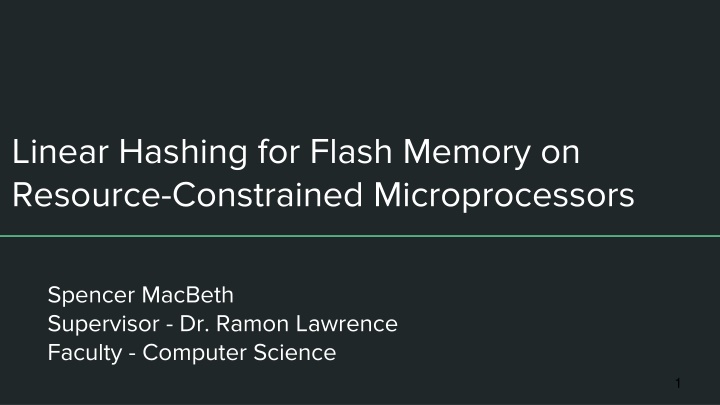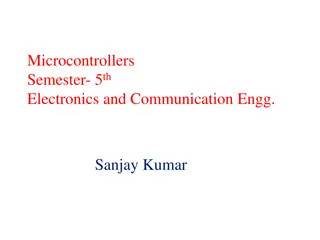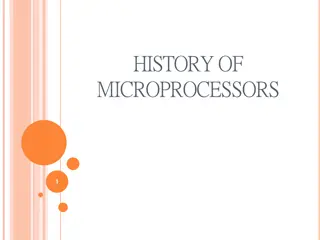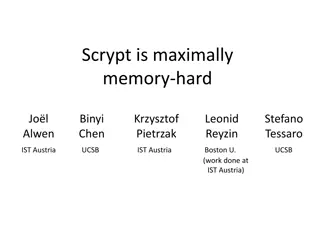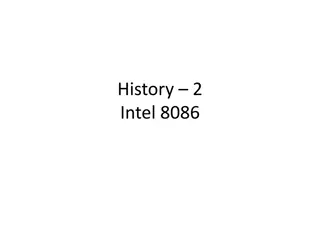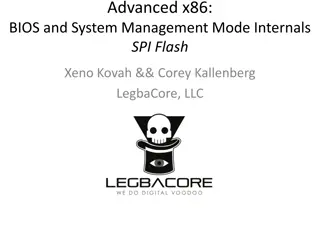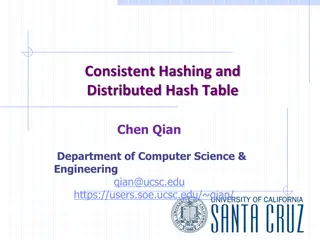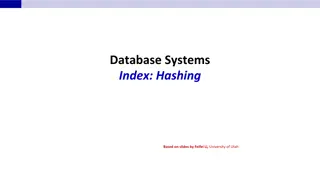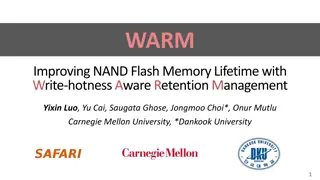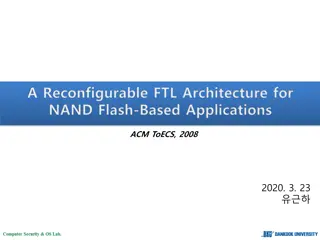Linear Hashing for Flash Memory on Resource-Constrained Microprocessors
This research focuses on evaluating the performance of linear hashing on the Arduino platform for efficient utilization of flash memory in resource-constrained microprocessors. Linear hashing is explored as a near-optimal data structure that maintains performance while conserving main memory, aiming to implement it for enhanced functionality on Arduinos.
Download Presentation

Please find below an Image/Link to download the presentation.
The content on the website is provided AS IS for your information and personal use only. It may not be sold, licensed, or shared on other websites without obtaining consent from the author.If you encounter any issues during the download, it is possible that the publisher has removed the file from their server.
You are allowed to download the files provided on this website for personal or commercial use, subject to the condition that they are used lawfully. All files are the property of their respective owners.
The content on the website is provided AS IS for your information and personal use only. It may not be sold, licensed, or shared on other websites without obtaining consent from the author.
E N D
Presentation Transcript
Linear Hashing for Flash Memory on Resource-Constrained Microprocessors Spencer MacBeth Supervisor - Dr. Ramon Lawrence Faculty - Computer Science 1
Overview Arduinos IonDB Flash Memory - An inexpensive, extensible, computing device with limited resources. - Capable of taking in input through an array of accessories, interfacing with it, and producing output - A high-performance implementation of a map data structure that can run in the Arduino environment - Currently has an interface which can use several different implementations with different tradeoffs - Becoming increasingly popular - Used in many small devices, including Arduinos - Has asymmetric read and write performance - Algorithms can adapted to exploit this property of flash memory 2
Research Objective: Assess the performance of the linear hash on the Arduino platform 3
The linear hash data structure has near-optimal performance for the basic hash table operations Motivations The linear hash maintains its performance while using little main memory Currently there is no implementation of a linear hash data structure for the Arduino platform 4
Terminology Stores a set number of records Storage units in 2D linked-list structure Bucket When a new record maps to a full bucket, an overflow bucket is created Overflow Bucket The number of records in the table divided by the table s current capacity Load Create new bucket and redistribute records in bucket pointed to by the split pointer Split 6
Diagram Records per bucket = 4 Load = 14 / 16 = 87.5% Capacity = 4 * 4 = 16 Split pointer = Bucket 0 7
Properties Insert, update, get, and delete run in O(1) Cost of splits remains relatively constant Constant Time Operations Size of table grows linearly in proportion to the number of records Linear Memory Usage Periodic splitting of buckets Hash function used makes a difference Average Bucket Load Relatively Constant Different parameter values can be used in different environments Configurable 8
Linear Hash Table Insertion Example start_size = 4; Suppose we had a linear hash table with the following characteristics: split_pointer = bucket 0; - - - - - - Initial size = 4 buckets 2 records per bucket Next bucket to split = 0 Split performed when load > 80% Records with id 2, 3, 4, 5, and 8 have been inserted Current load = (records / buckets * records_per_bucket) = 62.5% split_threshold = .80 h0(k) = k mod start_size h1(k) = k mod (2 * start_size) 9
Linear Hash Table Insertion Example start_size = 4; split_pointer = bucket 0; State after inserting 16 split_threshold = .80 - - - h0(16) = 16 mod 4 = 0 Bucket 0 is full so an overflow bucket is created Load = 6 / 8 = 75% h0(k) = k mod start_size h1(k) = k mod (2 * start_size) 10
Linear Hash Table Insertion Example start_size = 4; split_pointer = bucket 0; State after inserting 9 split_threshold = .80 - - - h0(9) = 9 mod 4 = 1 Load = 7 / 8 = 87.5% Since 87.5% is above the split threshold, a split is performed h0(k) = k mod start_size h1(k) = k mod (2 * start_size) 11
Linear Hash Table Split Example start_size = 4; - Add a new bucket with an index of n where n is the number of buckets before inserting For each record in the bucket to split: b0 = h0(record.key) b1 = h1(record.key) If (b0 != b1): Delete record from bucket b0 Insert record into bucket b1 Increment split pointer split_pointer = bucket 1; - split_threshold = .80 h0(k) = k mod start_size h1(k) = k mod (2 * start_size) - 4 12
Implementation for the Arduino Environment 13
Uses flash memory for programs Relatively high storage capacity from micro SD card (a 32 GB Lexar MicroSD card was used during testing) Specifications 8KB of RAM ATmega2560 4KB of local storage on device not used 14
Strategies Used Swap-on-Delete Reversed Linked-List When deleting a record, pluck the last record in the last bucket for this index and use it to fill the hole in the list. When creating an overflow bucket, instead of updating the tail bucket in the list, the new overflow bucket points to previous head. Consequences: Increased insert performance as empty location always known Consequences: Eliminates additional write during insert (which are more expensive than reads on flash) 3 additional disk accesses performed for every delete (read swap bucket, update swap bucket, write swap record) 15
Strategies Used Eager Deletions During Swap Bucket Caching In the IonDB standard, all records with the specified key are deleted. If the swap record retrieved has this key, it is deleted immediately. During operations where all records in a bucket are checked against some condition, the entirety of the bucket and its record is read into main memory. Consequences: Reduces the amount of disk accesses during deletes Consequences: Reduces amount of disk accesses by a factor of the amount of records per bucket on average This gain is proportional to the amount of records with the same key in the table Requires the cache be updated when datafile is mutated 16
INSERT Operation Time for Inserts vs Records in Table Insert time remains constant as linear hash grows Groupings demonstrate the triggering splitting (highest time grouping) and creation of overflow (mid level grouping) Group where time is consistently very low for inserts is when inserting into a bucket that is not full 17
GET Operation Time for Gets vs Records in Table Constant average retrieval time Some variance due to randomly generated values, some buckets will have more overflow buckets than others May require scan of linked list of overflow buckets 18
DELETE Operation Time for Deletes vs Records in Table Average delete time remains constant Some variance again due to randomly generated values, some buckets will have more overflow buckets than others In IonDB standard, performance of delete proportional to the amount of records that share keys 19
Record Distribution Record Counts in Bucket Groups Record distribution remains relatively equal Record Count in Group Polynomial string hashing was used on keys before bucket assignment to reduce collisions Groups of 50 Consecutive Buckets 20
Linear Hash vs. Flat File - Arduino Linear hash mean get time = 2.356 ms Flat file mean get time = 60.577 ms 22
Linear Hash vs. B+ Tree - PC Linear hash mean insert time = 0.148 ms B+ tree mean insert time = 0.160 ms 23
Conclusion: The linear hash data structure maintains its constant- time operations on the Arduino platform Swap-on-delete outperforms tombstoning for delete operations when conforming to the IonDB-standard The specific implementation of the linear hash used outperforms a B+ tree data structure on disk 24
A special thank you to Dr. Ramon Lawrence and Eric Huang for their continuous support and guidance! 25
